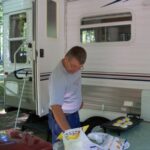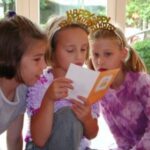Children love scavenger hunts. They love to be given a list of what fun items to find, and they love it even more when they find those items. They may feel a sense of pride or joy in knowing they were able to find those items. It makes them excited and happy, which can lead to a fun day for everyone!
There are many reasons to have a scavenger hunt. Whether it be a party, field trip, or just for fun. Take your little one or a group of children out for a of scavenger hunt. Spend a few hours or the whole day.
Scavenger hunts cannot only be a fun experience, but it can be a time of learning as well. Items on the lists can be types that make children think, but can be easy enough to make it an enjoyable experience. They will have so much fun; they may not even realize they are learning!
You can put whatever you would like on the scavenger hunt item list. Items of certain colors, numbers, shapes, and sizes. This can help your child learn to identify those items by those categories. It can help them to remember certain shapes or colors.
There are some things you should know before planning and taking your children out on a scavenger hunt. Here are some tips for planning out and going on a scavenger hunt with children.
1. Plan the list ahead of time. This will give you time to come up with items, a location, and an estimate of how long you want to be out (hunting in the daytime would be a better idea than in the night time).
2. Keep the list age appropriate for the child or children. Too many items that a child cannot identify or find may frustrate them.
3. Be sure the items on the list are kid friendly and safe. If they are not something a child can pick up, tell them to only point from a distance.
4. Be sure to take bags or such to carry items in if needed.
5. Make sure to have the necessary items, depending on where you are going: first aid kit, water, cell phone, etc. It is always better to be safe than sorry.
6. When going out on the actual scavenger hunt, make sure you go to a location you know well. Getting lost may put a damper on your day.
7. Head count before, during, and after, to be sure you have all of the children participating.
8. Stay with the children. Never let them run off on their own. The buddy system is okay to do, but stay as a group & keep the children close to you, especially if it is a crowded area.
9. Ask other adults that you know and trust to help you to go on the scavenger hunt if need be.
10. Do not be afraid to help the child if needed. It is encouraged to let the children try and figure it out for themselves, but dropping hints or doing the scavenger hunt together may work as well.
11. Depending on the area, be sure to keep the children at an appropriate behavior (no running, quiet or indoor voices, no climbing, etc.).
12. Encourage the children to do their best and to have fun!
When preparing your list, you can always organize your scavenger hunts into different themes. Doing so can help you come up with more ideas, while teaching children in a certain area (such as animals).
Here are a few themes, with the suggested scavenger hunt locations under them. Some locations may be the same (such as home or the library for looking at books, magazines, and such), while other may differ per theme (such as the zoo or grocery store). All locations should always be safe and appropriate for everyone.
Examples of the items on a scavenger hunt may include toys, pictures, books, magazines, the actual item itself (such as a rock, leaf, food, etc), and much more!
Animal Scavenger Hunt.
1. Favorite animal.
2. Big animals.
3. Small animals.
4. Animals that are only one color.
5. Animals with patterns on them (stripes, spots, etc.).
6. Animals that make sounds.
7. Animals that can fly.
8. Animals that can swim.
9. Animals with feathers.
10. Animals with fur.
Scavenger hunt locations can include: home, library, the zoo, or a pet store.
Nature Scavenger Hunt.
1. Insects.
2. Flowers.
3. Rocks.
4. Animals.
5. Leaves.
6. Twigs.
7. Seeds.
8. Grass.
9. Trees.
10. Dirt.
Scavenger hunt locations can include: home, library, park, or the zoo.
Shape Scavenger Hunt.
1. Circles.
2. Squares.
3. Triangles.
4. Rectangles.
5. Diamonds.
6. Hearts.
7. Stars.
8. Ovals.
9. Pentagon.
10. Octagon.
(Depending on the age group, the last two or 3 may be taken out and/or substituted).
Scavenger hunt locations can include: home, library, school, daycare center, or some place like a mall or grocery store.
Colorful Scavenger Hunt.
Items that are…
1. Red.
2. Blue.
3. Green.
4. Yellow.
5. Black.
6. White.
7. Purple.
8. Orange.
9. Brown.
10. Pink.
Scavenger hunt locations can include: home, library, school, park, grocery store, or basically anywhere that colors.
Healthy Food Scavenger Hunt.
1. Apples.
2. Oranges.
3. Bananas.
4. Grapes.
5. Pears.
6. Celery.
7. Carrots.
8. Broccoli.
9. Tomatoes.
10. Corn.
Scavenger hunt locations can include: home, library, grocery store, mall, etc.
Those are just a few of the many themes you can use for a scavenger hunt list. Use those themes, mix them up, or come up with a new theme altogether! Let the child display any items found (that can be kept) as a collage. Or even let them all have a show and tell session with their findings. However you do it, your child will learn, explore, and have fun!
Remember, when participating on these scavenger hunts, be safe together, learn together, and have fun together!






